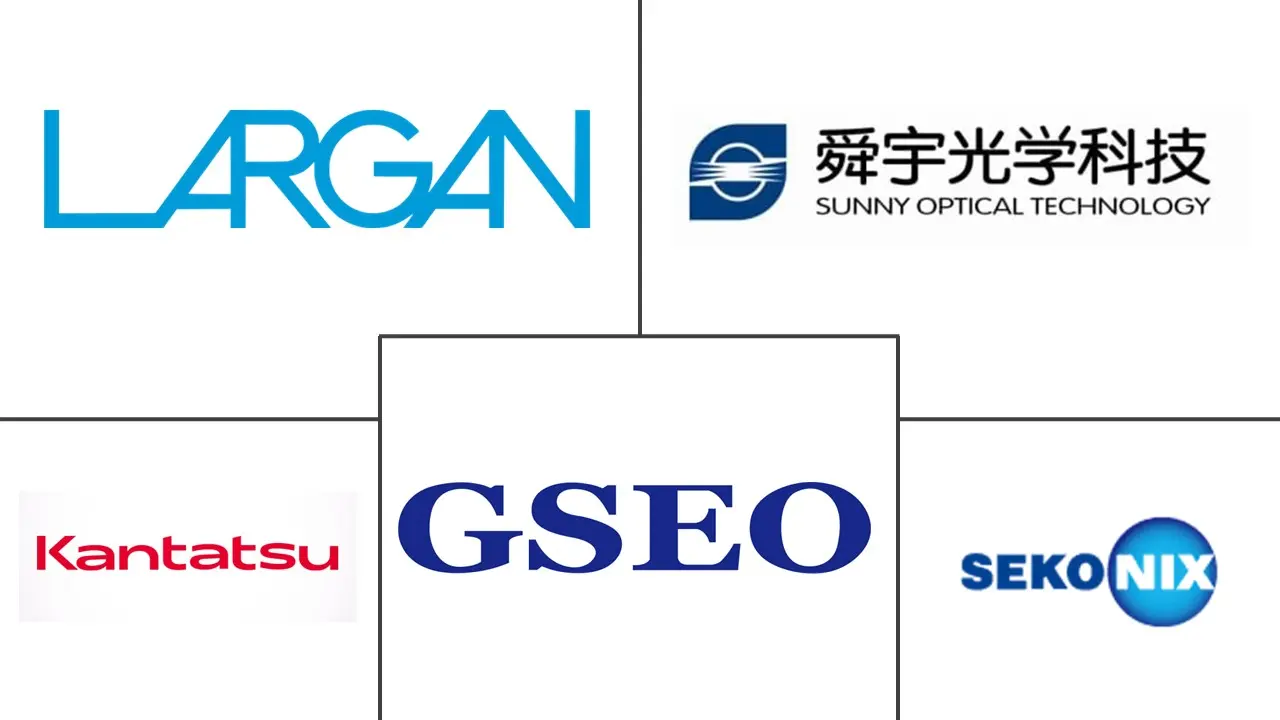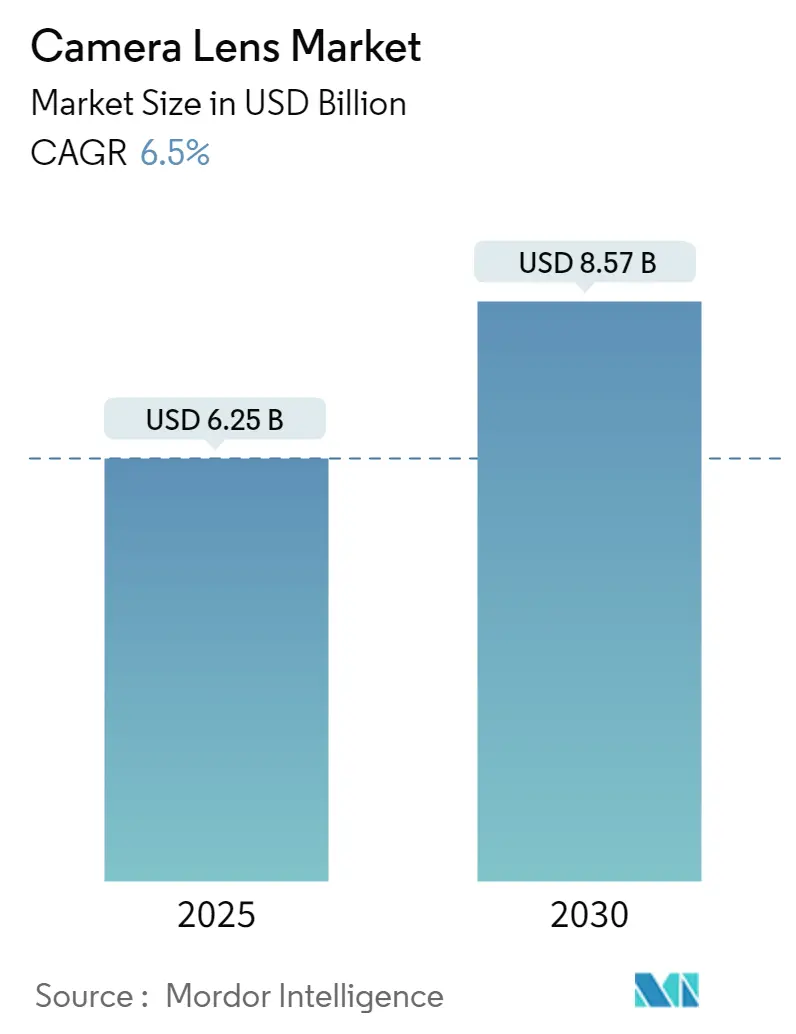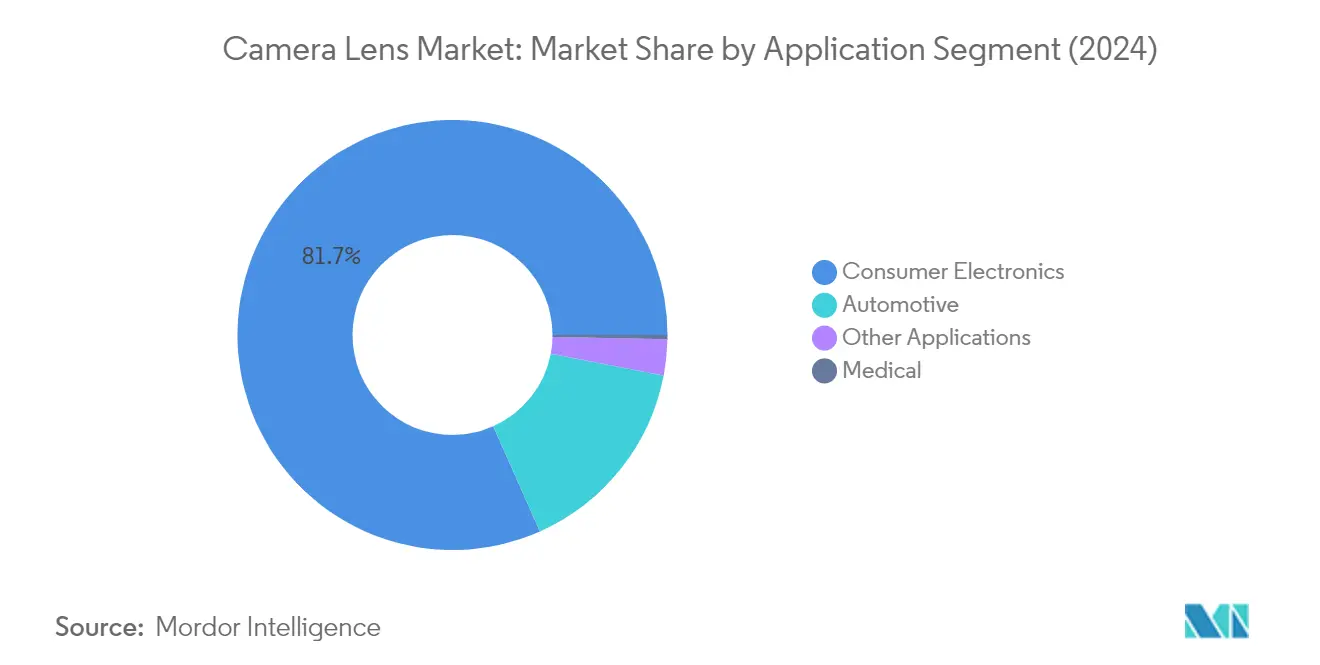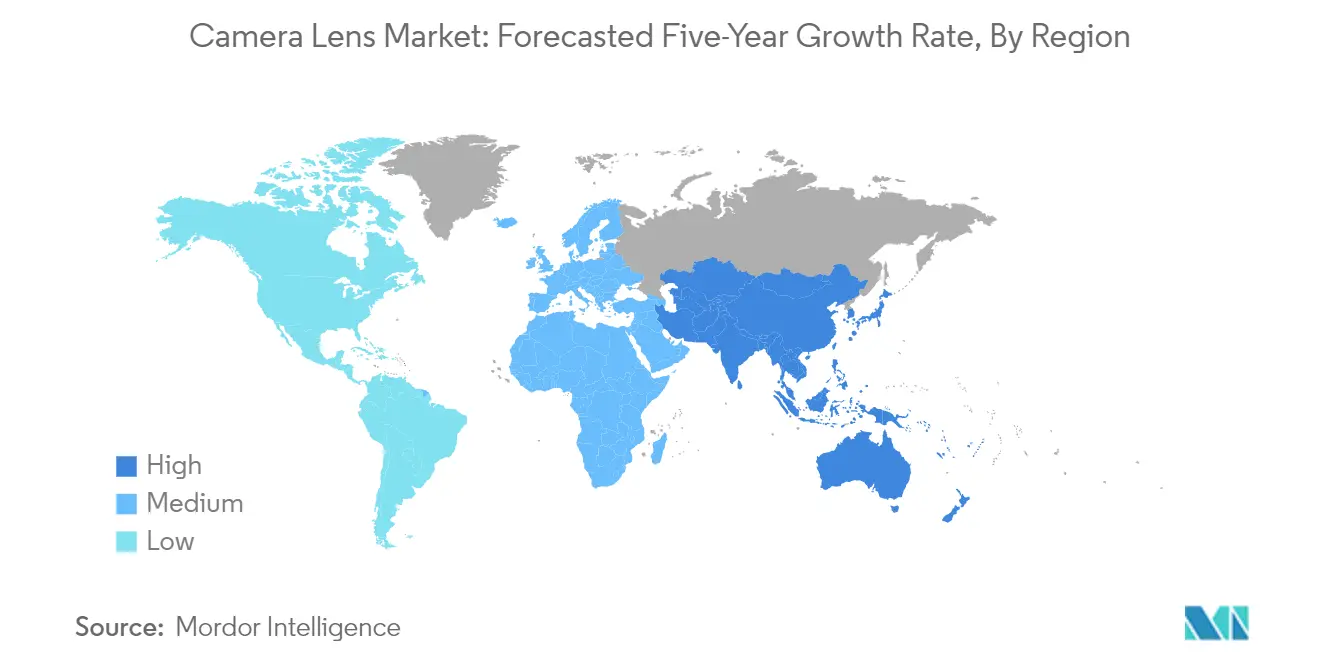Camera Lens Market Analysis
The Camera Lens Market size is estimated at USD 6.25 billion in 2025, and is expected to reach USD 8.57 billion by 2030, at a CAGR of 6.5% during the forecast period (2025-2030).
The camera lens industry is experiencing significant transformation driven by technological convergence and evolving consumer preferences. The integration of artificial intelligence and computational photography has revolutionized image processing capabilities, with camera lens manufacturers increasingly incorporating AI algorithms for enhanced image quality and real-time optimization. According to Ericsson's latest report, 5G mobile subscriptions are projected to exceed 5.3 billion by 2029, driving demand for advanced imaging capabilities in mobile devices. This technological evolution has led to the development of sophisticated multi-lens systems and innovative features like periscope zoom technology.
The industry landscape is witnessing substantial investments in research and development, particularly in advanced optical imaging technologies. In January 2024, LG Innotek made a strategic investment in AOE Optronics, a Taiwan-based lens manufacturer, to expand its presence in autonomous vehicle cameras and extended reality (XR) devices. This collaboration aims to enhance product design and manufacturing processes while focusing on quality improvement and price competitiveness. The partnership exemplifies the industry's shift toward integrated solutions that combine traditional optical expertise with cutting-edge digital technologies.
Manufacturing capabilities and production innovation continue to shape market dynamics, with major players expanding their facilities and adopting advanced manufacturing techniques. China's smartphone production reached approximately 1.6 billion units in 2022, highlighting the massive scale of manufacturing operations. Companies are increasingly focusing on developing specialized lens technologies, including liquid lens technology and retractable lens systems, to meet diverse application requirements while maintaining cost-effectiveness and production efficiency.
The convergence of professional photography and mobile imaging is reshaping consumer expectations and industry standards. A recent study by Suite48 Analytics revealed that 64% of professional photographers now use smartphones for more than half of their photographs, demonstrating the growing acceptance of mobile photography in professional settings. This trend has prompted manufacturers to develop innovative solutions like TECNO's V-shaped Adjustable Physical Aperture and Liquid Telephoto Macro Lens, announced in December 2023, which aim to bridge the gap between professional and mobile photography capabilities.
Camera Lens Market Trends
Growing Adoption of Smartphones Equipped with Professional-Grade Cameras
The adoption of smartphones equipped with professional-grade cameras has witnessed unprecedented growth, driven by technological advancements and changing consumer preferences. Smartphone manufacturers have significantly enhanced camera technology, incorporating high-quality lenses, advanced sensors, and sophisticated image processing capabilities. These improvements include larger sensors, multiple lens configurations, optical image stabilization, advanced autofocus systems, and computational photography techniques, enabling smartphones to capture high-quality images with exceptional detail, dynamic range, and low-light performance.
Recent developments in the industry underscore this trend, with manufacturers continuously pushing the boundaries of mobile photography. In January 2024, Realme announced the launch of its Realme 12 Pro Series, featuring an advanced periscope telephoto lens designed to enhance night shot clarity and stability while minimizing flare and ghosting. Similarly, TECNO introduced several groundbreaking imaging technologies in December 2023, including a V-shaped Adjustable Physical Aperture and an industry-first Liquid Telephoto Macro Lens, demonstrating the industry's commitment to innovation in mobile photography.
Increased Usage of Camera Lenses in Autonomous Vehicles
Camera lenses have become integral components in autonomous vehicles, providing crucial visual information about the vehicle's surroundings through a comprehensive 360-degree view system. These cameras, strategically positioned on all sides of the vehicle, enable real-time detection of obstacles, pedestrians, and other vehicles, forming a critical part of the vehicle's perception system. The demand for advanced driver-assistance systems (ADAS) is expected to increase significantly over the next decade, driven by regulatory requirements and consumer interest in safety applications.
The automotive industry's commitment to camera technology is evidenced by recent strategic developments. In January 2024, TIER IV unveiled Edge.Auto, an innovative product encompassing various autonomous driving system components, including automotive-grade cameras with impressive dynamic ranges of 120dB and resolutions ranging from 2.5MP to 8.3MP. Additionally, LG Innotek's recent investment in AOE Optronics aims to strengthen the supply chain for autonomous vehicle cameras, highlighting the growing importance of high-quality camera lenses in the automotive sector. These developments are particularly significant given that autonomous vehicles are projected to account for about 12% of car registrations by 2030, according to Intel's forecasts.
Segment Analysis: By Application
Consumer Electronics Segment in Camera Lens Market
The Consumer Electronics segment dominates the global camera lens market, commanding approximately 82% of the total market share in 2024. This significant market presence is primarily driven by the widespread integration of advanced photographic lens systems in smartphones, tablets, laptops, and other consumer electronic devices. The segment's dominance is further reinforced by the increasing consumer demand for high-quality photography capabilities in mobile devices, with manufacturers continuously enhancing their camera specifications to meet these expectations. The rise of social media platforms and content creation has also contributed substantially to the segment's growth, as users increasingly rely on their electronic devices for photography and video recording. Additionally, the emergence of AR/VR technologies and the growing adoption of multiple camera setups in smartphones have further solidified the segment's market leadership.
Medical Segment in Camera Lens Market
The Medical segment is emerging as the fastest-growing segment in the camera lens market, projected to expand at a robust CAGR of approximately 14% during the forecast period 2024-2029. This remarkable growth is driven by the increasing adoption of advanced imaging technologies in medical procedures, diagnostics, and surgical applications. The integration of artificial intelligence with medical imaging systems has opened new opportunities for enhanced diagnostic capabilities and real-time analysis. The segment's growth is further fueled by the rising demand for minimally invasive procedures requiring high-quality endoscopic imaging lenses and the increasing adoption of remote patient monitoring systems. The development of specialized medical camera lenses with superior resolution and precision for applications such as surgical microscopes, endoscopes, and diagnostic imaging equipment continues to drive innovation in this segment.
Remaining Segments in Camera Lens Market by Application
The Automotive and Other Applications segments complete the camera lens market landscape, each serving distinct and crucial roles. The Automotive segment is experiencing significant growth driven by the increasing integration of advanced driver assistance systems (ADAS) and the development of autonomous vehicles, requiring multiple high-quality imaging lenses for various safety and navigation functions. The Other Applications segment, which includes security, industrial, and specialized applications, continues to evolve with the increasing adoption of surveillance systems, machine vision applications, and industrial automation. Both segments benefit from ongoing technological advancements in lens design and manufacturing, contributing to the overall market's diversification and growth. The inclusion of specialized lenses such as zoom lenses, prime lenses, macro lenses, and telephoto lenses in these applications further enhances their functionality and market appeal.
Camera Lens Market Geography Segment Analysis
Camera Lens Market in North America
The North American camera lens market, comprising the United States and Canada, holds approximately 25% of the global camera lens market share in 2024, establishing itself as a crucial region for camera lens manufacturers. The region's market is primarily driven by the robust adoption of advanced smartphone technologies and the growing implementation of autonomous vehicle systems. The presence of leading automotive manufacturers and the increasing focus on vehicle safety features have created substantial demand for automotive camera lenses. The region's strong emphasis on technological innovation, particularly in areas such as advanced driver assistance systems (ADAS) and surveillance systems, continues to fuel market growth. Additionally, the increasing adoption of 5G technology and the growing trend of professional mobile photography have created new opportunities for camera lens manufacturers. The market also benefits from the region's strong research and development infrastructure, which facilitates continuous innovation in lens technology and design.
Camera Lens Market in Europe
The European camera lens market has demonstrated consistent growth from 2019 to 2024, maintaining an annual growth rate of approximately 6%. The region's market is characterized by strong demand from both consumer electronics and automotive sectors, with countries like Germany, France, and the United Kingdom leading the adoption of advanced camera technologies. The European market's growth is largely attributed to the region's stringent safety regulations in the automotive sector, particularly regarding the implementation of advanced driver assistance systems. The region's strong focus on technological innovation, particularly in areas such as autonomous vehicles and surveillance systems, continues to drive market expansion. The presence of leading automotive manufacturers and their increasing focus on vehicle safety features have created substantial demand for automotive camera lenses. Furthermore, the growing adoption of smartphones with advanced camera capabilities and the increasing popularity of professional mobile photography have created new opportunities for camera lens manufacturers in the region.
Camera Lens Market in Asia-Pacific
The Asia-Pacific camera lens market is projected to grow at a robust CAGR of 7.4% during the period 2024-2029, positioning itself as the fastest-growing region globally. The region serves as a major manufacturing hub for smartphone production, with countries like China, Japan, South Korea, and India leading the way. The market's growth is driven by the increasing adoption of smartphones with advanced camera capabilities and the rising demand for high-quality imaging solutions. The region's strong presence in consumer electronics manufacturing, coupled with growing investments in automotive and surveillance technologies, creates a favorable environment for market expansion. The emergence of local manufacturers and their focus on technological innovation has intensified market competition and driven product development. Additionally, government initiatives supporting electronics manufacturing and the growing middle-class population's increasing disposable income have created new opportunities for market growth.
Camera Lens Market in Latin America
The Latin American camera lens market, encompassing key countries such as Brazil, Mexico, and Argentina, demonstrates significant growth potential driven by increasing smartphone penetration and automotive sector development. The region's market is characterized by growing demand for advanced camera technologies in both consumer electronics and automotive applications. The establishment of new manufacturing facilities by global smartphone manufacturers has created new opportunities for camera lens suppliers. The market benefits from the region's growing middle-class population and increasing adoption of advanced mobile technologies. Additionally, the automotive sector's growth, particularly in Brazil and Mexico, has created substantial demand for vehicle camera systems. The region's increasing focus on public safety and surveillance systems has also contributed to market expansion, while government initiatives supporting technology adoption continue to create favorable conditions for market growth.
Camera Lens Market in Middle East & Africa
The Middle East & Africa camera lens market demonstrates promising growth potential, driven by increasing technological adoption and infrastructure development. The region's market is characterized by growing demand for advanced camera technologies in both consumer electronics and surveillance applications. The increasing smartphone penetration, particularly in countries like the UAE and Saudi Arabia, has created new opportunities for camera lens manufacturers. The market benefits from the region's focus on smart city initiatives and the implementation of advanced surveillance systems. The automotive sector's growth, particularly in the Gulf Cooperation Council (GCC) countries, has created additional demand for vehicle camera systems. Furthermore, the region's increasing investment in tourism infrastructure and security systems continues to drive market expansion, while government initiatives supporting digital transformation create favorable conditions for sustained growth.
Camera Lens Market Overview
Top Companies in Camera Lens Market
The camera lens companies market is characterized by intense competition among established players who are continuously investing in research and development to maintain their market positions. Camera lens manufacturing companies are focusing on developing advanced lens technologies like glass-plastic hybrid lenses, wafer-level optics, and specialized coatings to enhance image quality and functionality. Operational agility is demonstrated through strategic manufacturing facility expansions, particularly in Asia-Pacific regions, to meet growing demand and optimize production costs. Market leaders are forming strategic partnerships with smartphone manufacturers and automotive companies to strengthen their presence in these rapidly growing segments. Additionally, camera lens companies are expanding their product portfolios to cover diverse applications ranging from consumer electronics to industrial automation, while also investing in automation and quality control processes to maintain competitive advantages.
Market Dominated by Asian Manufacturing Giants
The camera lens market structure is characterized by the strong presence of large Asian conglomerates, particularly from Japan, South Korea, and China, who have established themselves as dominant players through decades of technological expertise and manufacturing excellence. These companies have built comprehensive ecosystems encompassing research, development, manufacturing, and distribution networks, making it challenging for new entrants to gain significant camera lens market share. The market shows moderate consolidation, with key players like Largan Precision, Sunny Optical Technology, and Samsung Electro-Mechanics holding substantial market shares while maintaining strong relationships with major smartphone and camera manufacturers.
The industry has witnessed strategic mergers and acquisitions aimed at expanding technological capabilities and market reach, particularly in emerging segments like automotive cameras and specialized industrial applications. Companies are increasingly focusing on vertical integration strategies to maintain control over their supply chains and enhance operational efficiency. Regional players are also emerging, particularly in specialized segments, though they face significant challenges in competing with established global players who possess superior technological capabilities and economies of scale. The market dynamics are further influenced by long-term partnerships between lens manufacturers and their customers, creating high barriers to entry for new players.
Innovation and Adaptability Drive Future Success
Success in the camera lens market increasingly depends on companies' ability to innovate and adapt to rapidly evolving technological requirements across different applications. Incumbent players must continue investing in research and development to maintain their technological edge, while also expanding their manufacturing capabilities to meet growing demand from diverse end-user segments. Companies need to focus on developing specialized solutions for emerging applications in autonomous vehicles, augmented reality, and industrial automation, while maintaining strong relationships with key customers in traditional segments like smartphones and digital cameras. Additionally, manufacturers must optimize their production processes through automation and advanced quality control systems to maintain competitive cost structures.
For contenders looking to gain camera lens market share, focusing on niche segments and developing specialized solutions for specific applications presents a viable strategy. Success factors include building strong intellectual property portfolios, establishing strategic partnerships with key customers, and maintaining flexible manufacturing capabilities to adapt to changing market demands. The risk of substitution remains relatively low due to the specialized nature of optical technology, though companies must continue innovating to stay ahead of emerging technologies. Regulatory compliance, particularly in automotive and medical applications, is becoming increasingly important, requiring manufacturers to maintain robust quality management systems and certification processes. Companies must also consider environmental regulations and sustainability requirements in their product development and manufacturing processes.
Camera Lens Market Leaders
-
Largan Precision Co. Ltd
-
Sunny Optical Technology (Group) Co. Ltd
-
Kantatsu Co. Ltd
-
Genius Electronic Optical Co. Ltd
-
Sekonix Co. Ltd
- *Disclaimer: Major Players sorted in no particular order
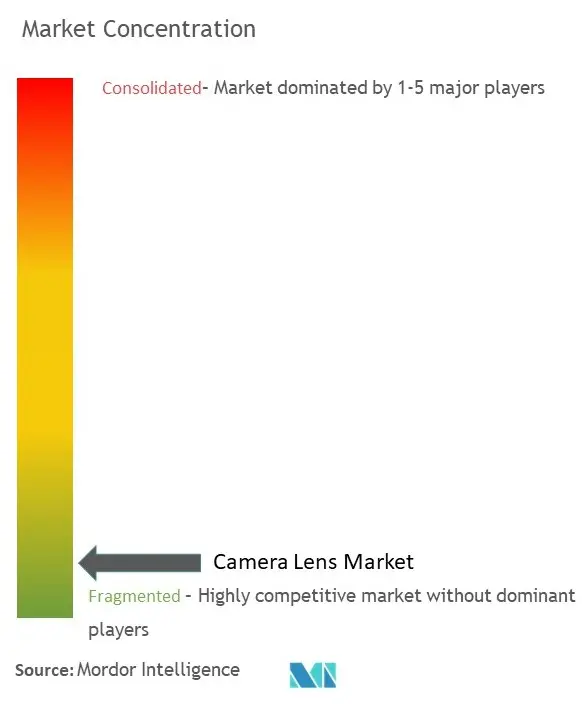
Camera Lens Market News
- September 2023: Tamron Co. Ltd announced the launch of the 150-500 mm F/5-6.7 Di III VC VXD (Model A057), a Nikon Z mount system compatible with an ultra-telephoto zoom lens for full-frame mirrorless cameras. The 150-500 mm F5-6.7 lens has a focal length of 500 mm on the telephoto end, yet it provides a remarkably compact size and extremely high image quality throughout the entire zoom range. It lets users enjoy spontaneous shooting in the ultra-tele realm where conventional wisdom once dictated a tripod. The ultra-telephoto zoom is equipped with the VXD (Voice-coil eXtreme-torque Drive) precise and high-speed linear motor autofocus mechanism and TAMRON's proprietary VC (Vibration Compensation) mechanism. At the 150 mm end, this versatile lens offers a MOD (Minimum Object Distance) of 0.6 m (23.6 in) for powerful and dramatic close-ups.
- September 2023: Cooke Optonics announced the launch of the new SP3 series of full-frame prime lenses for your mirrorless camera. The new SP3 range is available in five focal lengths and comes with various user-changeable mounts. These lenses are small, lightweight, and robust in construction. The new SP3 range has five focal lengths: 25 mm, 32 mm, 50 mm, 75 mm, 100 mm, E-Mount RF-Mount, L-Mount. The SP3 is Cooke's lightest lens, weighing between 500 g/1.10 lbs and 690 g/1.52 lbs, including the lens mount. These lenses are easy to use on lightweight gimbals and also on drones. Their robust construction and mechanicals will also match the rigors of high-speed shooting environments.
Camera Lens Market Report - Table of Contents
1. INTRODUCTION
- 1.1 Study Assumptions and Market Definition
- 1.2 Scope of the Study
2. RESEARCH METHODOLOGY
3. EXECUTIVE SUMMARY
4. MARKET INSIGHT
- 4.1 Market Overview
-
4.2 Industry Attractiveness - Porter's Five Forces Analysis
- 4.2.1 Bargaining Power of Suppliers
- 4.2.2 Bargaining Power of Buyers
- 4.2.3 Threat of New Entrants
- 4.2.4 Threat of Substitute Products
- 4.2.5 Intensity of Competitive Rivalry
- 4.3 Industry Value Chain Analysis
- 4.4 Assessment of the Impact of Macroeconomic Factors and COVID-19
-
4.5 Technology Snapshot
- 4.5.1 Built-in Lens
- 4.5.2 Interchangeable Lens
5. MARKET DYNAMICS
-
5.1 Market Drivers
- 5.1.1 Growing Adoption of Smartphones Equipped with Professional Grade Cameras
- 5.1.2 Increased Usage of Camera Lens in Autonomous Vehicles
-
5.2 Market Challenges
- 5.2.1 Mass Manufacturing Challenges
- 5.2.2 Decreasing Profit Margins in the Industry
6. MARKET SEGMENTATION
-
6.1 By Application
- 6.1.1 Consumer Electronics
- 6.1.1.1 Mobile
- 6.1.1.2 AR/VR/MR
- 6.1.1.3 Other Consumer Electronics
- 6.1.2 Automotive
- 6.1.3 Medical
- 6.1.4 Other Applications
-
6.2 By Geography
- 6.2.1 North America
- 6.2.2 Europe
- 6.2.3 Asia-Pacific
- 6.2.4 Latin America
- 6.2.5 Middle East & Africa
7. COMPETITIVE LANDSCAPE
- 7.1 Vendor Positioning Analysis
-
7.2 Company Profiles*
- 7.2.1 Largan Precision Co. Ltd
- 7.2.2 Sunny Optical Technology (Group) Company Limited
- 7.2.3 Kantatsu Co. Ltd
- 7.2.4 Genius Electronic Optical Co. Ltd
- 7.2.5 Sekonix Co. Ltd
- 7.2.6 Canon Inc.
- 7.2.7 AAC Technologies Holdings Inc.
- 7.2.8 Ability Opto-Electronics Technology Co. Ltd
- 7.2.9 Sunex Inc.
- 7.2.10 Tamron Co. Ltd
- 7.2.11 Haesung Optics Co. Ltd
- 7.2.12 O-film Group Co. Ltd
- 7.2.13 Samsung Electro-mechanics Co. Ltd
8. INVESTMENT ANALYSIS
9. MARKET OPPORTUNITIES AND FUTURE TRENDS
Camera Lens Market Industry Segmentation
A camera lens is an optical device that focuses and captures light to create an image. It is an essential camera component and plays a crucial role in determining the quality and characteristics of the photographs taken. Several types of camera lenses are available, each with unique features and applications. Some lenses include the Prime Lens, Zoom Lens, Wide-angle Lens, Telephoto Lens, and Macro Lens. In a film camera, the lens sends the light to the film strip, while in a digital camera (like DSLR or mirrorless camera), the lens directs light to a digital sensor.
The study tracks the revenue accrued through the sale of the camera lens market by various players across applications, including consumer electronics, automotive, and medical in the global market. The study also tracks the key market parameters, underlying growth influencers, and major vendors operating in the industry, which supports the market estimations and growth rates over the forecast period. The study further analyses the overall impact of COVID-19 aftereffects and other macroeconomic factors on the market. The report’s scope encompasses market sizing and forecasts for the various market segments.
The camera lens market is segmented by application (consumer electronics [mobile, AR/VR/MR, other consumer electronics], automotive, medical, other applications), by geography (North America, Europe, Asia-Pacific, Latin America, Middle East & Africa). The report offers the market size in value terms in USD for all the abovementioned segments.
| By Application | Consumer Electronics | Mobile |
| AR/VR/MR | ||
| Other Consumer Electronics | ||
| Automotive | ||
| Medical | ||
| Other Applications | ||
| By Geography | North America | |
| Europe | ||
| Asia-Pacific | ||
| Latin America | ||
| Middle East & Africa |
Camera Lens Market Research FAQs
How big is the Camera Lens Market?
The Camera Lens Market size is expected to reach USD 6.25 billion in 2025 and grow at a CAGR of 6.5% to reach USD 8.57 billion by 2030.
What is the current Camera Lens Market size?
In 2025, the Camera Lens Market size is expected to reach USD 6.25 billion.
Who are the key players in Camera Lens Market?
Largan Precision Co. Ltd, Sunny Optical Technology (Group) Co. Ltd, Kantatsu Co. Ltd, Genius Electronic Optical Co. Ltd and Sekonix Co. Ltd are the major companies operating in the Camera Lens Market.
Which is the fastest growing region in Camera Lens Market?
Asia Pacific is estimated to grow at the highest CAGR over the forecast period (2025-2030).
Which region has the biggest share in Camera Lens Market?
In 2025, the Asia Pacific accounts for the largest market share in Camera Lens Market.
What years does this Camera Lens Market cover, and what was the market size in 2024?
In 2024, the Camera Lens Market size was estimated at USD 5.84 billion. The report covers the Camera Lens Market historical market size for years: 2019, 2020, 2021, 2022, 2023 and 2024. The report also forecasts the Camera Lens Market size for years: 2025, 2026, 2027, 2028, 2029 and 2030.
Our Best Selling Reports
Camera Lens Market Research
Mordor Intelligence provides comprehensive industry analysis and market outlook for the camera lens market, covering key segments like telephoto lens, zoom lens, and smartphone camera lens applications. Our detailed research encompasses market size, growth forecasts, competitive landscape of major camera lens companies, and emerging trends in optical imaging and photography equipment market. The report includes in-depth analysis of both traditional camera lens manufacturers and emerging players in the interchangeable lens market, providing stakeholders with actionable insights available in an easy-to-read report PDF format.
Beyond market research, our consulting expertise helps stakeholders navigate the complex camera lens industry landscape through technology scouting, product positioning assessments, and new product launch tracking. We support businesses with customer need analysis, competition assessment, and go-to-market strategies specific to various segments like cinematography lenses, professional camera lens, and mirrorless camera lens categories. Our team conducts extensive B2B surveys and interviews with industry experts, combining data visualization techniques to provide actionable intelligence for strategic decision-making in the evolving photography equipment market.

